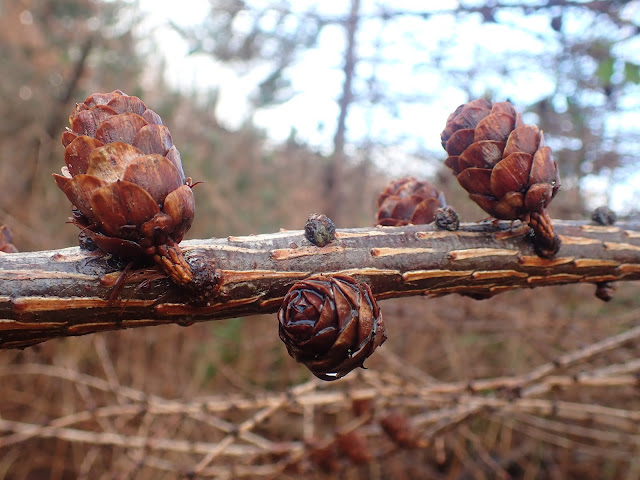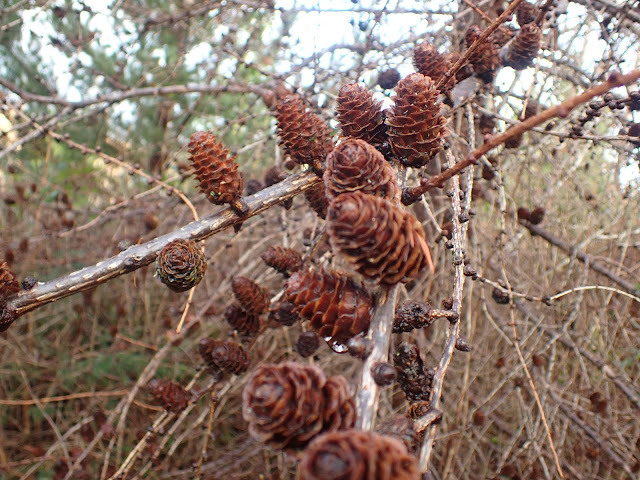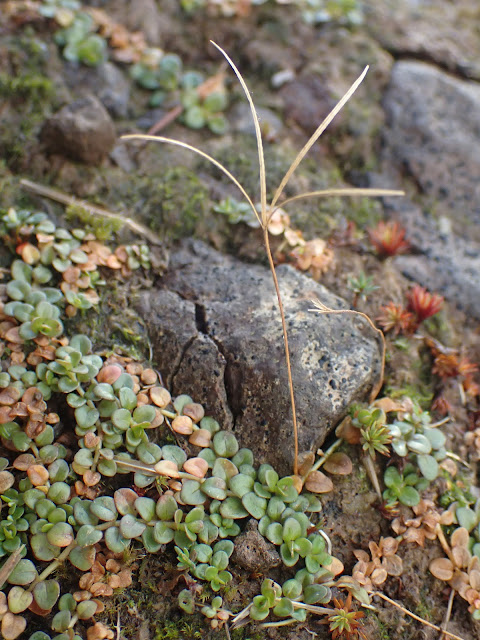The weather forecast suggested that today would be wet. I looked out the window and disagreed, it looked pretty good to me. I shoved my waterproof trousers into my rucksack just in case, donned my hat and coat and headed out into a bright and chilly day.
I had a cunning plan. My PSL currently stands at 6499 species and I'd already spied what I believed would be number 6500 a few weeks back. Today I would claim my 6500th British species! The venue was Kingsburgh Woods, located about four miles south of here. Ordinarily there are shedloads of dogwalkers, kids on bikes, people being noisy etc, but today I did a nice wee circuit and didn't see or hear a soul. Very refreshing indeed!
Kingsburgh Woods is a community owned forest with good tracks through the trees and across the surrounding hills. Three or four years back there was a fire which devastated a large tract of forest and hillside, the glow of which was clearly visible from here of a night. The result was wall to wall Rosebay Willowherb, also known as Fireweed (now I know why). Other plants soon began to colonise the burned areas including conifers, self-sown from the surrounding plantation trees. Mostly Sitka Spruce, but also quite a lot of Lodgepole Pine which, in its native American habitat, is well-known as an early coloniser of burnt ground. Sitka of course will merrily colonise anywere, fire-cleared or not. It's a natural born thug and will undoubtedly become a huge problem in years to come.
 |
| Young Lodgepole Pines Pinus contorta amongst Rosebay Willowherb thickets |
 |
| The terminal buds are heavily coated in resin |
I later found a larger Lodgepole Pine, also self-sown, with many cones in evidence. It's a bit of a record shot (it was the other side of a deer fence and I was fully zoomed in) but you can see the cones pointing downwards against the main stem. Lodgepole Pine cones can remain in situ for many years, often being seen adpressed at intervals all the way up the main trunk.
Sitka stands out like a sore thumb when seen alongside other conifers, it has a distinctly bluish look from afar.
 |
| Green-coloured Lodgepole Pine on the left, bluish-coloured Sitka Spruce on the right |
Sitka is also a lot more 'jabby' than most other conifers. As the saying goes, if you can grab it and it doesn't hurt it's not a Sitka! There's a beautiful specimen in the grounds of Armadale Castle, a huge monstrous beast and very impressive. But mostly they are scruffy invaders dotted around the hillsides. I found one larger specimen with cones, again not a great shot as there was a water-filled ditch between me and it.
 |
Sitka Spruce Picea sitchensis - and just check out that blue sky!
|
But what about species 6500, I hear you cry! I'm just getting to that. There has been an awful lot of larch planted in Kingsburgh Woods, including the block visible from the road as you pass by. There's a moratorium on planting larch nowadays thanks to Phytophthora ramorum, but there are lots of surviving plantation trees and their self-seeded progeny can nearly always be found nearby. From a distance, I was happy these trees weren't European Larch Larix decidua; the twigs were too deeply coloured and not at all pendulous. Clearly they were either Japanese Larch Larix kaempferi or Hybrid (Dunkeld) Larch Larix x marschlinsii. For no good reason other than they seemed chunky and quite dark-coloured, I favoured Japanese Larch - which would be number 6500 for me.
I set off up a track and soon found a load of self-seeded larch some way from the tall planted trees. I took lots of pics of the cones, these being the main ID character between the three taxa. Back-up ID features included twig colour, twig hairiness and overall look of the tree. The first few trees were clearly Hybrid Larch, with their elongated cones bearing slightly 'loose-fitting' scales
Hmmm...not what I was hoping for. I continued onwards and found another group of young larches. Again, I took a barrage of images
 |
| Nicely recurved scales and perhaps more globose than elongated |
This looked fairly good for Japanese Larch, though I worried that the twig was perhaps a little too pale and slender. A check through the handlens revealed the twig to have scattered small hairs, another good sign. But one cone does not a Japanese Larch make. I cast around for clues and didn't like what I saw
 |
| Recurved scales yes, but with distinctly ovoid-shaped cones - and just look how fecund it is! |
This too was Hybrid Larch, though with closer affinites to Japanese Larch than the previous example. Annoyingly, every single larch I checked proved to be the hybrid, including a few with blonde-coloured branches, a feature of European Larch. These hybrids are a menace, they seem to exhibit a sliding scale of characteristics between the parent plants rather than being nicely intermediate. Ho hum, I shall keep on looking, Japanese Larch is out there somewhere!
There's an excellent talk about larches in Britain by Matt Parratt, BSBI referee for conifers, which you can watch by clicking
here.
Whilst checking conifer cones, I noticed clusters of small, round cones which momentarily confused me until I realised I was looking at Alder Alnus glutinosa saplings. Yep, some deciduous trees have cones too! Of course, Alder also has catkins. And a lovely bud too, I reckon.
 |
| These 'cones' are last year's female catkins that have turned woody |
 |
| These are this year's male catkins. Note the tiny female catkins just forming behind them |
 |
| Rather smart, I think. There are three bundle scars on each leaf scar |
Staying with catkins a moment longer, there were plenty of Hazel Corylus avellana with catkins starting to open up. No sign of any female flowers yet, but the male catkins were certainly pretty obvious
I shall have to grab a Hazel catkin and take some pics of it through the barrel of my microscope, they're fantastic things to examine under high magnification. The female flowers are pretty special too, looking like a small bud with a spray of shockingly vivid red styles exposed for all to see. One for next time!
There were a number of other plants of interest, though diversity was generally a bit low. I doubt I saw more than about sixty species, but yearticks included Hybrid Larch, Tormentil, Rowan, Lodgepole Pine, Alder, Common Knapweed, Bird's-foot Trefoil, Sea Plantain and Wood-sorrel.
 |
| New Zealand Willowherb and Early Pampas-grass - two highly invasive species |
 |
| Elder Sambucus nigra is always very early to put out new growth |
Just in case anybody wondered if I'd moved on from chugging riffs, nope not at all! This is probably one of my all time favourite Sabbath tracks. Ozzy doesn't so much sing the words, he damn well puts his entire body into telling the story! How his voice has survived for so long is testament to technique, it may sound like unhealthy shrieking but it really ain't. Oh and yeah, don't forget those mahoosively chugging riffs. Hope you enjoy!





























All-time classic. But that cover :D I'm sure my record of Japanese Larch is completely kosher ... hmmm ...
ReplyDeleteYour link led me here - https://www.youtube.com/watch?v=Da_eDk5q9qU - Elms, I thought I knew those, now I know I don't. There are two old trees in my Wee Wood, I'm suspecting ID may be a challenge I'd presumed they were Ulmus glabra, hopefully they are, although confirming that may be a challenge?
ReplyDeleteHow weird, I double-checked and it should take you directly to the larch talk. It does for me! The correct link is https://youtu.be/_jgOZ10h1Ug Wych Elm diffres from other elms in how the seed is situated between the wings, plus I suspect the buds are quite different. It's the only elm on Skye, so I'm a bit out of practice with them. But the page you link to should be able to tell you better than I can.
Delete